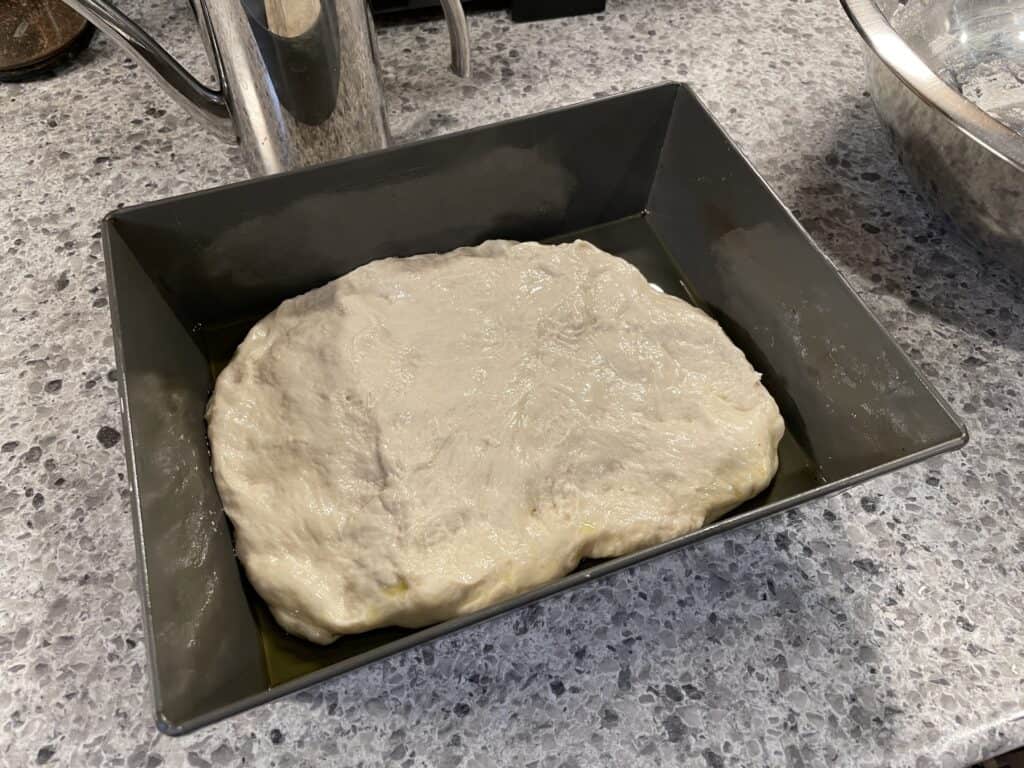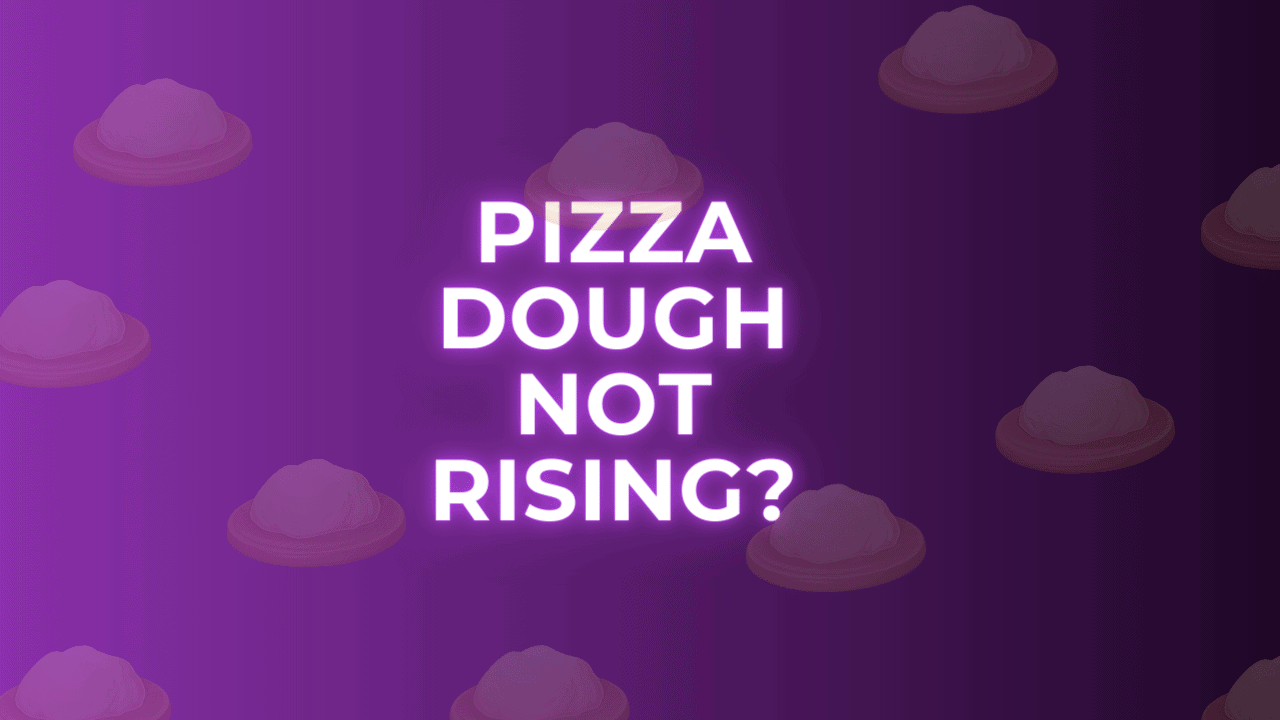There’s nothing worse than checking on your pizza dough…
…only to find it hasn’t risen.
*womp womp…
I always feel deflated when this happens (get it??)–and since it takes TIME, ENERGY, AND MONEY to make your own pizza–you want to get it right!
Here are the top reasons your dough might not be rising:
- The yeast amount is wrong
- The temperature in your room is too cold
- The yeast is dead
- The yeast got too hot
- You didn’t cover your dough
- You didn’t knead properly
- Your pizza is actually over-proofed

Let’s get into WHY your pizza dough isn’t rising–and I’ll even share a few tips and tricks to fix a flat dough (you don’t always have to throw it out)!
Let’s rise 👍
7 Reasons Your Pizza Dough Isn’t Rising/Proofing:
1 – You Messed Up the Yeast Amount
How much yeast you put in your dough depends on several things:
- Time – how long is your proof? Are you cold-proofing overnight? LESS yeast is required for longer proofs
- Temperature – what’s the temperature in your proofing room? 65F and 70F actually require different amounts of yeast! And then there’s cold-proofing…dough rises much slower
- Type of yeast – Fresh vs Instant Dried Yeast vs Active Dried Yeast vs Sourdough. Each of these activates differently and develops dough differently.
If you’re new to pizza-making, I highly recommend sticking to proven recipes or using a dough calculator! You absolutely need to nail the correct amount of yeast you’re using!

Too little yeast for your proofing time & room temperature = your dough probably won’t rise enough.
Solution = Let the dough rise longer (even if you have to push dinner back longer).
2 – The Room (Temperature) Is Too Cold
If you live in warm climates and your kitchen usually sits above 70F, that’s great! Yeast needs warm temperatures (and moisture) to properly activate and proof your dough!
But if you have colder rooms, you might need to include more yeast up front to rise properly.
For standard recipes you find on the internet, anything less than 67F-68F will generally require either…
- more yeast
- more rise time
I live in Michigan, so I stick to the pizza dough calculators that allow me to input my room temperature–to make sure I’m using the proper amount of yeast.
I usually store my proofing dough on TOP of the refrigerator, as that area generally stays a bit warm.
3 – The Yeast Is Dead
If you’re using dried yeast from the store (Active or Instant), you’ll always want to “check the yeast” to make sure it’s actually alive!
Sometimes yeast just goes bad!
(You can check the expiration date on the package, but in my experience, yeast actually expires faster than that).
“Checking yeast” will be slightly different depending on the yeast you use–but most of the time you can simply mix together:
- The water portion of your recipe
- The yeast
- The sugar portion of your recipe (or honey, or oil)
Let the mixture sit for 5-15 minutes (mine doesn’t do ANYTHING after 5 minutes. It usually takes 10-15!). Look for bubbling activity in the mixture.
If it’s bubbling, the yeast is usually fine and doing it’s job.
If not, your yeast might be dead.
4 – The Yeast Is Too Hot
Yeast activates when you add it to “warm” water, which is how you make pizza dough.
But like any other organism, yeast can die if you put it into water that is TOO hot.
If you accidentally used boiling water to mix your dough–you may have killed your yeast (and that’s probably why your dough isn’t rising)!
5 – You Didn’t Cover Your Dough
Yes, you should absolutely cover your dough when proofing.
Go read that article for more–but covering your dough locks in moisture and prevents air from drying out the surface of your dough.
A stiff, dry surface of your dough could prevent the dough from expanding (which means less rise).
It won’t necessarily kill your fermentation process–but it can certainly cause your dough to rise slower.
Use a damp towel or plastic cling wrap and cover your dough!
6 – You Didn’t Knead Your Dough (Properly)
Whether your using a stand mixer or hand-kneading–a good kneading session is important for proofing your dough!
Kneading not only mixes your ingredients–but also develops the gluten in your dough.
What does gluten do?
The gluten in your dough essentially forms structures that trap your yeast and air together–forcing them to hang out together. This is what causes fermentation (leaving air bubbles of carbon dioxide), and THIS is what causes your dough to rise.
If you skipped the kneading phase (or did a really poor job), your yeast may have not gotten “locked up” with the air–which could explain under-proofed dough.
Related Reading: Are Bread Flour and Pizza Flour the Same?
7 – Your Pizza Is Actually “Over-Proofed”
This happened to me when I first started out…
I thought my dough was under-proofed and didn’t rise–but I had accidentally used more than triple the amount of yeast required.
My dough had risen and proofed WAY faster than I expected–and the dough I was looking at had actually done past the “good risen” phase and turned into mush again.
And how can you know if your dough is over-proofed?
If it’s no longer “springy” or “bouncy,” and the air bubbles have popped.
If you think it’s only slightly over-proofed–you can actually try shaping it back into balls and trying to bake it anyways.
How to Fix Dough That Won’t Rise
If you check your dough only to find it hasn’t appropriately risen–there are actually a few things you can try to salvage the pizza.
1 – Place in an oven with boiling water.
If yeast is still alive in your dough, you might try the combo of “more heat and moisture.”
- Do NOT heat your oven
- Place your dough on the lowest rack (probably on a baking pan or bowl)
- Boil some water and put it in a separate baking pan
- Place the pan of water into the oven and shut the door
Yeast likes moisture and warm temperatures. Leaving your yeast in the oven for 20-60 minutes could result in more rise.
2 – You can add an additional infusion of yeast
Check out this video to see how:
You can basically mix up ANOTHER small bowl of…
- Yeast
- Warm water
- Sugar (for the yeast to feed on)
Then, you can mix it into your dough ball and then allow it to proof/rise some more.
I have never tried this one before, but I imagine you would have to do this if you think your yeast is dead or killed.
Pizza Proofing F.A.Q.s
What is proofing?
Dough “proofing” or “fermenting,” is the process of resting your dough after mixing (and kneading) that lets the chemical reactions rise your dough. The yeast activates and eats the sugars, triggering chemical reactions that develop the flavor and structure of your dough.
How long is too long to proof pizza dough?
48-72 hours is generally the max, but how long you proof dough will depend on the type of pizza you make, the temperature where the dough will be proofed, and the amount of yeast you use! However, you can check if a dough is “over-proofed” by checking for air bubbles and “springy-ness.” If the texture of the dough doesn’t bounce back when you press it, and feels flat and dead, it was probably proofed too long.
How do I fix Underproofed pizza dough?
There are two things you can try. First, try setting your dough in the oven and adding a baking pan of boiling water (don’t turn the oven on). This warmth and moisture could kickstart the dough. Also, you could try mixing an additional bowl of yeast, water, and sugar, and kneading that into the dough. A yeast infusion.

